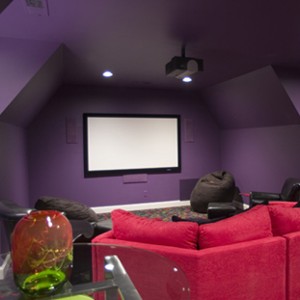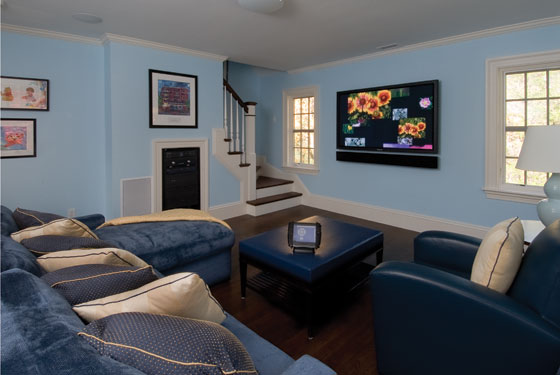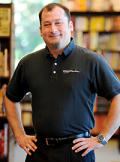
Why You Can’t Go Totally Wireless: 4 Network Topologies to Consider
Committing solely to wireless technology is ‘a recipe for failure’ for integrators. Here are the four home network infrastructure options to consider for every project.
Commitment certainly has its place in this world, like in relation to spouses or sports teams. But over-committing to a singular technology? That can be a risky move.
While Wi-Fi is the technology buzzword, particularly with homeowners, those of us tasked with actually fitting the myriad of modern electronics and digital services into a high-functioning, seamlessly networked home must understand the whole landscape.
What makes the current 802.11 Wi-Fi standards so alluring is the convenience of its mobility, ubiquity, and interoperability between so many devices. While the appeal is that Wi-Fi is seemingly in everything—our computers and smartphones, our televisions and cameras—that is also part of the problem. The 2.4GHz spectrum is being shared by all of your Wi-Fi devices, all of your neighbors’ Wi-Fi devices, and even proprietary devices such as baby monitors.
That’s quite a load. When the physical limitations of RF bands are strained or exceeded, it reduces the quality of service for every device, and consequently every person relying on them.
Those limitations are the source of audio drop offs, buffering delays or reduced definition during a streaming movie, and latency in competitive multiplayer video games. These nuisances undermine the intent of quick, reliable access to content, which is the very point of incorporating many technologies into the home. Your customers deserve better than that.
Part of the solution can be to use the 5GHz band for 802.11n or the upcoming 802.11ac standard to help alleviate some bandwidth traffic, but these options are not without their own limitations. First, the 5GHz band has less range than 2.4GHz and struggles to pass through walls and other building obstacles. Second, many devices today only communicate on 2.4GHz. While additional devices are expected to be dual band, 2.4GHz will continue to be the most used band in the near future.
So, truthfully, the real solution is recognizing wireless is not the be all, end all. And that’s okay. What a network needs to be about is uninterrupted access and content, and it falls on the installer’s shoulders to ensure the best user-experience.
Networking a home with a strong wired backbone remains the best practice to achieve top performance. Should an existing home have only a limited wired Ethernet network, a coax network using the MoCA standard, or a powerline network using the HomePlug AV standard, may be able to bridge the Ethernet service to the desired destination. Both of these wired technologies are affordable and easy-to-install networking alternatives that can relieve the Wi-Fi network of its highest bandwidth responsibilities. This will ensure superior performance for streaming and surfing on mobile and smart devices.
At the end of the day, all customers really care about is streaming that movie on Netflix with a pristine picture, synced audio, and no interruptions. Committing solely to a specific technology is a recipe for failure. Employing multiple technologies to build a complete, robust networking solution that can handle multiple applications is often the best solution.
Knowing Your Networking Options
When it comes to home networking, some technologies get more press than others these days (like, wireless). However, there are many viable options out there, each suited to address particular needs and overcome specific obstacles. Understanding all of the technologies available allows you to make the educated call on how best to accomplish each stage of designing a strong network for the technology-filled home.
Here’s a quick roll call of the networking players:
The Not-Extinct Ethernet Option: This option remains tried and true. Despite the introduction of newer alternatives with impressive stats and advantages, the truth is that nothing is faster, more reliable, or more secure than wired Ethernet systems. The solution already offers throughput capabilities of up to a Gigabit per second in a 1000BaseT network and 10Gbps for a commercial oriented 10GBaseT network using Cat 6a.
And innovation hasn’t stopped finding new uses of Ethernet, either. HDBaseT has made it viable to use Ethernet cables for transmitting HDMI signals over long distances, enabling streaming of high definition video and audio around to multiple areas from a central location. Though retrofitting Ethernet installations into existing homes can be costly and labor intensive, it is the best option for steady, high-quality performance.
The Up-and-Coming Coax Option: For existing homes with a limited Ethernet network, coax networking is emerging as a feasible alternative technology. Commonly referred to as MoCA (Multimedia over Coax Alliance) in deference to the technology’s leading standards body, this technology is already built into most cable boxes for multi-room DVR functionality. MoCA works reliably by transmitting over a frequency band unused by cable TV transmissions.
MoCA can also be used to stream video and audio to areas of the home that were previously without streaming service. The most frequently used MoCA standard today, 1.1, has a throughput of 170Mbps. The speed and reliability of this offering, paired with its ease to employ and cost-effectiveness, make it an attractive choice.
The Not-To-Be-Overlooked Powerline Option: The powerline option uses the readily available electrical lines to extend a home network’s reach. Though early powerline technologies encountered many issues, making some installers wary of the technology, the more recent standards from the HomePlug Powerline Alliance deserve due consideration due to better performance and greater stability. The HomePlug AV2 specification, introduced in 2012, delivers a maximum throughput of 500Mbps. It’s also the simplest of networking equipment options to configure. Merely plugging in two powerline networking modules gets a quick auto-confirmation of the connection within seconds. The modules then act as transmitters or receivers for data signals over the electrical line, and with most hardware, provide extra Ethernet ports for incredible flexibility.
Like all technologies, this one also has limits and obstacles. One obstacle is surge protectors, which can block network transmissions. Powerline also suffers from greater signal loss and more noise than Ethernet cable or coax, making it the third best option for high-bandwidth applications. However, for a simple and convenient solution, powerline technology may be the best fit for a fast extension of the wired network.
The Ubiquitous Wireless Option: Wireless is the new “it” thing. It’s the enabler for all mobile applications and often thought to be the networking option that makes your customer the true master of his or her space . It’s an undeniably flexible solution, which can offer speed and convenience to both you and your customers. Since its formation in 1999, the Wi-Fi Alliance has governed the evolution of the most commonly used standards. The most recent standard, 802.11n, was released in 2009 and boasts an impressive maximum speed of 300Mbps with the capability to broadcast over two frequency bands, 2.4GHz and 5GHz.
The convenience of Wi-Fi is why it’s so frequently turned to for streaming our entertainment. But it also has limitations: Scarce bandwidth, range limitations and vulnerability to interference all need to be considered in the network design, and many of these limitations or shortcomings can be avoided by offloading high-bandwidth applications to wired networks where possible.
The key to constructing the most robust home network is assessing the best solution for the right application. There is no single solution that meets the performance expectations and budget of every application. Installers must understand the strengths and limitations of each solution so they can best service the needs of their customers.
By Tom Cunningham
http://www.cepro.com/article/why_you_cant_go_totally_wireless_4_network_topologies_to_consider/?utm_source=CEPWeekly&utm_medium=email
Custom Installation Services, LLC – First choice for low voltage wiring and home networking in Charlotte, NC and surrounding areas
Posted in Automation, Blu-ray, Bose Dealer, Gaming Systems, Home Theater Design, Home Theater Setup, i-Pad, IP Cameras, Linksys, Low Voltage Contractors, Luxul, Multi Room A/V, Netgear Routers, Network Setup, News, Structured Wiring, technology, Wireless Network
|
Tagged Best Buy, Bose Dealers Charlotte nc, Bose SoundTouch, central vac dealers in charlotte nc, Charlotte, charlotte custom home builders, charlotte dirt devil dealers installers, Charlotte Home Theater, charlotte nc architects, charlotte tv installers, custom home builders in lake norman, def tech dealer charlotte, definitive technology dealer charlotte, Denon, geek squad in charlotte nc, hdmi cables, home audio consultation and design, home automation companies in charlotte, home network installation, Home theater design, IP cameras charlotte, martin logan dealers charlotte, multiroom audio, new home wiring charlotte nc, russound charlotte, samsung tv dealers charlotte, sharp tv dealers charlotte, speaker wiring charlotte, survallence cameras, Universal Remote programmers in charlotte nc, URC, whole house audio, wireless installers charlotte
|
Time to Tune Up Your Home Theater?
Make your old system new again
Home theaters have been around for some time now. Sure, the screens have become bigger and the speakers more powerful. Throw in a media streamer or server, and the way a home theater looks and behaves today is a lot different than it did just five years ago. So, veteran owners of home theaters, is it time to update? Should you invest in new gear? Or, maybe there are some simple tweaks you can make that’ll have your home theater humming like it’s brand new.
We asked a few seasoned custom electronics professionals (CE pros) for their recommendations. Some of the suggestions you might be able to do yourself; for others you will probably need the help of a pro. Regardless, “A/V systems need maintenance just like anything else we use daily, like cars, HVAC systems and computers. There will always be maintenance needs and costs associated with your system,” says Jason Voorhees of Cantara Design, Costa Mesa, Calif., Many CE pros offer home theater tune-ups as part of maintenance package. Expect to spend between $125 to $300 for the service, which may include just a few updates or many, depending on the system specifics.

Dust off your equipment: Dust can cause home theater components to run at a higher operating temperature, potentially decreasing their lifespan. Any components that have accessible filters (projectors, media servers, PC, etc.), should be cleaned once a year.
Audio Tuning: If you originally tuned your system (or had a professional do it) right after taking your speakers out of their boxes, it’s almost a given that the elastic properties of your drivers have changed over time. As the drivers loosen up from use, the sound they produce can change. It is probably time to re-tune.
Settings: Assuming your home theater system is 1080p capable, make sure all of your devices are set to output at 1080p, include satellite and cable boxes, Apple TVs, etc.
Brightness: One thing that can decrease over time is the brightness of your video display, especially that of projectors. Every display has some built-in picture modes; these settings are often called Vivid, Dynamic, Movie, Standard, 3D, etc. You may find that by simply adjusting a picture mode that you suddenly have a better looking video display.
Update: If your system isn’t 1080p and HDMI, it should be. You’ll open your theater up to a world of high-def and streaming services.
Calibrate: refocus and recalibrate the projector; recalibrate the surround-sound system.
Firmware: Install and test new firmware updates for every part of your system. The updates may fix bugs or may make new features available.
Seats & Curtains: Clean and test all of the theater seating, and repair if necessary. If the theater has curtains, they should be cleaned also.
Batteries and Bulbs: If any components use rechargeable batteries (remote controls, power supplies, etc.), test them and replace if necessary. Replace dead light fixtures.
Clean the Screen: Use a tape-based lint roller on the black fabric frame (if you have a fixed screen). You’ll be amazed at how much dust this material attracts. For a fixed screen use a soft horse-hair brush to gently brush off the screen surface. If you have a roll-up screen, bugs like to fly into the roller and get embedded into the screen. Call the manufacturer to determine what kind of cleaning solution is best.
Test Tone: How do you know if a tweeter or a crossover is blown on one of your speakers if you don’t spend 20 minutes doing a simple test tone sweep on each speaker? Not sure if the tweeter is working? Put your hand over the tweeter and listen to the speaker. If the sound doesn’t change, you probably have a problem. Your listening tastes may change too, and by calibrating yearly for level, distance and speaker position (if your speakers are moveable), you’ll be able to tune-up according to your changing tastes.
Delete: Spend 10 minutes deleting channels you don’t watch from your DirecTV or cable TV on-screen guide.
Reboot: Reboot your DVR every 2 months. You might be surprised at how much faster it will operate.
New Additions: Many older home theaters have a set-top box, a DVD player and a local library of content on a media server, but may not have a streaming media player. It’s time to get an Apple TV, Roku or some other device that can stream content to your home theater. This might also involve reprogramming your remote and adding new cabling.

by Lisa Montgomery
http://www.electronichouse.com/article/time_to_tune_up_your_home_theater/D1/
Custom Installation Services, LLC – Your Home Theater Tune Up Specialists Charlotte, NC and surrounding areas
Posted in 3d movies, 3D TV, Audio Demos, Audio Systems, Automation, Blu-ray, Flat Panel TV's, Gaming Systems, HDMI Specs, Home Theater, i-Pad, IP Cameras, LED, Media Rooms, Multi Room A/V, Music and Movies, Outdoor Speakers, Panamax, Sports Bar, Structured Wiring, technology, Theater Seating
|
Happy New Year To Everyone!
 With the holidays and our busier than normal schedule over the past month, it has been a while since I have posted a blog. So, this will be different than my normal format of product news. I wanted to post a personal blog to thank all of our loyal clients for your support over the past year. 2010 was a good year for C.I.S., with new product offerings added to our lineup, as well as new and exciting technology trends. None of which would have been possible without everyone’s continued support! With the holidays and our busier than normal schedule over the past month, it has been a while since I have posted a blog. So, this will be different than my normal format of product news. I wanted to post a personal blog to thank all of our loyal clients for your support over the past year. 2010 was a good year for C.I.S., with new product offerings added to our lineup, as well as new and exciting technology trends. None of which would have been possible without everyone’s continued support!
A new direction for us this year was to “dabble” in more commercial A/V installations. These included sports bars as well as an overhaul of the video at Lance, Inc. This has opened up a new revenue stream for C.I.S., and one we will continue as we move forward into the future. As part of this new commercial business, C.I.S. has partnered with ZEE-VEE, makers of high definition boxes that enable 1080p over coax for long distance runs and combining signals to existing channels for ease of use.
Another new product in our lineup is from SpeakerCraft, with their addition of the “FloBox”. The FloBox is a single unit that allows you to dock your iPod, iPhone or iPad, play a CD, stream from the internet, access iTunes or listen to FM radio. Combined with substantial amplification, quality drivers and a sleek, futuristic cabinet available in five finishes, the FloBox will transform any room into a concert hall at the push of a button!
I would like to again thank everyone for your continued support, and to a great 2011! Stay tuned for more of my traditional blogs with product news and updates!
Don Miller
President
Custom Installation Services, LLC – We specialize in fixing the $99 TV install by our “competitors”!
Posted in 3d movies, 3D TV, Audio Systems, Automation, Blu-ray, Flat Panel TV's, Gaming Systems, Home Theater, i-Pad, LED, lighting control, Line Conditioners, Lutron Radio Ra II, Media Rooms, Multi Room A/V, Music and Movies, News, Panamax, recycling, Structured Wiring, technology, Theater Seating
|
Tagged 3d theater in charlotte, audio advice, Best Buy, central vac dealers in charlotte nc, charlotte audio advice, charlotte hd installers, Charlotte Home Theater, Charlotte onkyo dealers, custom home builders in charlotte nc, geek squad in charlotte nc, HD installers in Charlotte nc, home audio consultation and design, home automation companies in charlotte, home theater furniture, marantz dealers in Charlotte nc, Mooresville, multiroom audio, speakercraft dealers in charlotte nc, surround sound, tv installation, tweeter charlotte, Universal Remote programmers in charlotte nc, whole house audio, zobo
|
|
|
|






